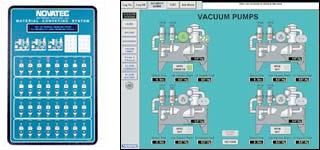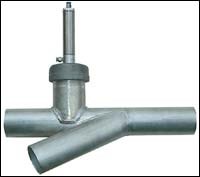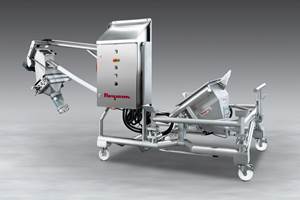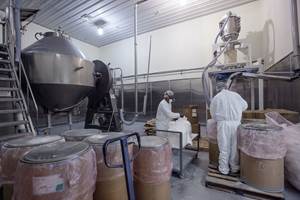How to Get a Handle on Materials-Handling Problems
The best way to avoid materials-handling problems is to design and install the system properly in the beginning.
The best way to avoid materials-handling problems is to design and install the system properly in the beginning. Keep in mind some basic principles:
- Minimize the number of elbows, vertical lifts, and length of flexible hose.
- Size pumps using these rules:
1 horizontal ft = 1 equivalent ft
1 vertical ft = 2 equivalent ft
1 90° elbow = 20 equivalent ft
1 ft of flex hose = 3 equivalent ft
An average railcar is 66 ft long
- Avoid up-sloping material lines.
- Choose carefully between a dedicated-line system with purge and a common-line system. Dedicated lines cost more initially and reduce throughput somewhat, but they avoid line clogs and ensure more reliable operation. Dedicated lines should definitely be used in a Just-In-Time system to avoid overfilling the small vacuum chambers.
- Decide whether dry-air-conveying or purging is right for your needs.
- Choose a control system that will meet current and anticipated future needs and can be understood by your employees. Some of today’s more exotic control systems do a lot of troubleshooting automatically. They include alarms for vacuum-pump motor failure, high vacuum, low vacuum, clogged filters, bag breaks, high amp readings, and motor phase. The initial cost for this level of sophistication leads most processors to opt for controls that have a simpler panel just showing the status of chambers and pumps.
Starting up a new system
If a problem crops up when first starting up a material-handling system, it can be solved by answering the following questions:
- Is the station turned on? Verify its status at the controller.
- Is the vacuum line physically attached to this station?
- Is the material hose/line attached to the proper hopper, surge bin, or gaylord? If you are using source valves, verify that the proper valve is assigned to this station.
- Is the source valve opening and closing properly?
- Is enough air mixing with the material? The system cannot move material without air mixed into it. Check the air probe at the source and make sure that the probe is at least 50% open.
- Do material hoses have any holes or breaks?
- Is the material flowing freely from the source?
- Is it clogged in the hopper?
- Is there sufficient material at the source point?
- Is material clogged in the line?
- Is the flapper sealing properly against the dump throat on the vacuum chamber? If there are grommets on the bottom of the dump throat, make sure the flapper seals properly against the grommets. Conical valves are sometimes used to seal the dump throat, but they are relatively expensive.
- Is one station loading correctly and the others are not? Check that station to verify that the valve is not stuck in the open position. This will prevent other stations from loading properly.
Most common problems
When a working system develops a problem, it is typically that one or more stations suddenly do not fill properly. One’s first instinct may be to lengthen the load time. That will not solve the problem. Instead, you need to find out what has changed in the system.
One of the most common problems in pneumatic conveying systems is failure of four-way solenoid control valves. This is almost always caused by foreign particles from the compressed-air lines and usually occurs during installation and start-up. The four-way solenoid that controls station valves requires clean, dry, oil-free air. A compressed-air filter/separator can virtually eliminate such problems with these valves.
A drop in throughput
Pellet materials require sufficient air to be transported. Insufficient air will cause material to alternately surge and hesitate in the lines, reducing throughput. The cure is to gradually increase the air in the lines by adjusting the air mixing valve at the material source, and the throughput will usually increase.
Clogged filters in vacuum chambers, vacuum takeoff boxes, and vacuum pumps are the most frequent cause of reduced throughput. Inspect and clean them regularly and don’t forget to empty the catch pans under cyclone filters. If the pans fill up, dust can be pulled back through the system to clog the filters.
A loss of vacuum will also cause throughput to drop. The gauge at the vacuum pump should read 5 to 9 in. of Hg while the system is running. A lower reading indicates a vacuum leak.
To check vacuum in the system:
- Remove the vacuum line from the inlet to the cyclone.
- Cap off the cyclone inlet with duct tape, or cover it with your hand.
- Push the pump “Start” button. The high-vacuum relief should open. (It will sound like a bird chirping.) This will let you know the pump is sealed properly. The vacuum gauge should go to at least 12 in. of Hg.
- If the vacuum relief doesn’t open, there is an air leak at the pump. Check the seal on the cyclone’s dump can, the filter-housing lid seal at the pump, the vacuum breaker valve (verify it has air at 85 to 100 psi), and all piping connections.
- If the relief valve opens, reconnect the vacuum line to the system and do the same check. If the relief valve opens, the system is sealed and all station “T” valves are closed.
- If the valve doesn’t open, you have a vacuum leak. Check the system for open lines, open station valves, or lack of air to the station “T” valves.
- Make sure that all vacuum chambers are sealed, all hose and pipe connections are tight, and look for holes in material lines that can be worn by glass-filled materials or excessive conveying velocities. Use stainless or ceramic elbows for abrasive resins.
Plugged material lines
This problem is typically related to a lack of transport air. The surging described above can pack material into the lines. With virgin pellets, simply remove the material line from the material source and the plug should break up. If this works, slightly increase the air flow by adjusting the air mixing valve to avoid a recurrence.
Regrind and even virgin material can pack in the lines hard enough to require manual removal. The plug has to be isolated and each end of the affected pipe must be opened and the plug forced out with a rod. Sufficient transport air is the best preventative.
‘Starved’ vacuum chambers
If material is not reaching vacuum chambers beyond a particular station in a common-line system, check for an overfilled vacuum chamber. A reverse-flow check valve is typically located inside the vacuum chamber at the material inlet. Filling the vacuum chamber above this check valve will cause it to be held open when another chamber attempts to load from the shared line. The resulting vacuum loss will prevent material conveyance to all other chambers on the shared line. Chambers should be filled nearly to the level of the check valve but not above it. Decrease the load time; or, if more material needs to be loaded in a single shot, add a spacer below the check valve or switch to a larger chamber.
Not in time for JIT?
Common-line systems should not be used with JIT (Just-in-Time) loaders. The problem is that some material tends to miss the turn at a lateral (or “Y”) pipe like a driver missing a highway exit. When the vacuum ceases down this leg, this “bypass material” will come to rest just past the “Y.” This creates a problem for JIT systems because the bypass material can be more than the shot size (often 1 lb or less), causing the station to repeatedly call for material. A station farther down the line may clear the bypass material, overfilling its small JIT chamber and holding the check valve open.
If this condition becomes chronic, install a diverter valve in place of the standard lateral pipe. The diverter automatically forces material to go to its assigned station. Better yet, use dedicated material lines for JIT applications to pre-empt this problem.
A common line can usually be used with larger vacuum chambers because when enough material misses the turn, the remaining material will be forced to make the turn at the lateral. When the bypass material does clear, it usually won’t overfill a larger chamber.
About the Authors: Tom Spangler is service manager at Novatec, Inc. in Baltimore. Les Mischaud is installation manager, and John Kraft is a marketing specialist.
Related Content
Mobile Sanitary IBC Unloading and Conveying System
Transfers contamination-sensitive bulk solid materials from IBCs to downstream processes, dust-free.
Read MoreCut Loading Time Through Direct Charge Blending
Direct charge blender loading, a vacuum-powered automation process, can dramatically improve loading time and reduce material costs. In this article, we address ten common questions to help you determine if the systems are right for your facility.
Read MoreConveyor Controller Ideal for Expanding Plants
Billed as the most flexible and reliable discrete wired conveying controller on the market.
Read More‘Digitalization’ – Awkward Term for a Vital Concept
At K 2022, 85 machines from 40 companies showed off their Industry 4.0 capabilities via OPC-UA interface. A new universal interface for Material Supply Systems was revealed at the show.
Read MoreRead Next
Advanced Recycling: Beyond Pyrolysis
Consumer-product brand owners increasingly see advanced chemical recycling as a necessary complement to mechanical recycling if they are to meet ambitious goals for a circular economy in the next decade. Dozens of technology providers are developing new technologies to overcome the limitations of existing pyrolysis methods and to commercialize various alternative approaches to chemical recycling of plastics.
Read MoreUnderstanding Melting in Single-Screw Extruders
You can better visualize the melting process by “flipping” the observation point so that the barrel appears to be turning clockwise around a stationary screw.
Read MoreLead the Conversation, Change the Conversation
Coverage of single-use plastics can be both misleading and demoralizing. Here are 10 tips for changing the perception of the plastics industry at your company and in your community.
Read More













